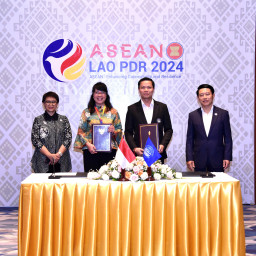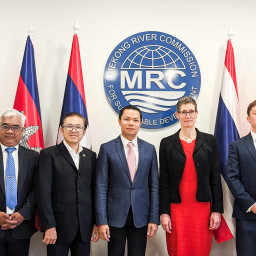Improving Navigation Channels While Protecting the Environment
China’s Mekong development plan have stirred debate as potentially becoming an environmental and social peril for downstream Mekong countries. China’s navigation channel improvement plan has recently attracted attention from environmentalists, activists, to the media alike. More so since mid of this year, when news reported waterway clearance by China was progressing into Thailand. The Bangkok post in several of its articles reported China’s rock-blasting plan would damage the Mekong 1, and most recently claimed ‘the environment will never be the same’.2
I would like to present another angle on this issue to give some balanced perspectives to readers of the Bangkok Post and other media. I believe it is not a question about choosing economic gains over environmental protection or vice versa. At the Mekong River Commission (MRC), we live by the motto “meeting the needs, keeping the balance”, which is endorsed by four Prime Ministers since their first MRC Summit in 2010. That is, development needs are legitimate, but they must take into account legitimate concerns of the environment and society.
The Mekong River is considered as one the least developed and least spoiled of the major rivers in the world. The Mekong is used for cargo and people transport, immensely in the downstream stretches. However, upstream navigability remains challenging. The upper Mekong is full of rocks, reefs and shoals that makes navigation difficult.
In fact, experience and skilled boatmen can still navigate year - round in the upstream areas but the boats are generally around 50-60 Dead Weight Tons (DWT) and specially designed to get through the rocks and rapids. Large-scale commercial boats cannot safely navigate the natural river. Channel improvement including removing the rocks and shoals, building dikes, dredging is needed. Surveys, studies and elaborate researches (morphology studies, water level assimilations and forecasts, mathematic model studies, Acoustic Doppler Current Profilers (ADCP discharge measurements), etc. have been made about the environmental impacts of channel improvements. Standards have been issued for Environmental Impact Assessment (EIA) with channel improvement projects.
The terminology “blasting the rapid” which is occasionally used in navigation channel improvement document and EIAs sounds extremely negative in comparison with the reality. The reader is incited to understand that a huge number of explosives is used to completely blow up the entire rapid, leaving only a deep gully from the explosion where ships can safely pass. But that is not true. The misunderstandings of different terminologies bring about uninformed oppositions against development of navigation, which is the only way of transporting goods and cargo in a user-friendly and environmentally friendly way. Also, such misunderstanding stems the desire for the authorities to return to, and favour road transport, which is by far the most polluting way of bringing goods and cargo from point A to point B, and stirs minimal or no objection from environmentalists.
Waterway experts have clearly proven that in most of the case studies, “clearing rapids” is barely a surgical intervention by which some rock outcrops and rocky river banks are chiselled (sometimes bedrock-deepened) and solitary rock outcrops in the navigation channel are removed and relocated. For the Keng Pha Dai rapid (Thailand), this is only 1.99% of the entire surface of the rapid that is “rock removed” or “blasted”.
The claims that so many fish die from the blast and so many habitats are destroyed is not true neither. In fact, the increasing use of high voltage electricity shocks that is now more frequently used by local fishermen to kill all fish within the operation area is the main destruction. But it happens unseen and unnoticed.
Some environmental reports torpedo waterway improvement for reason of the fish habitat destruction; but waterway experts claim that fish habitats are usually not in the immediate vicinity of navigation channels. They are rather in the side channels and pools, well away from the disturbances of the boat engine. These areas are even not touched by any waterway improvement.
To conclude, we should all take a step back, reflect and view development in an objective and informed way. Any development would need to consider and balance the economic gains, and the implications to the environment and people. Plans that improve waterborne transport are in line with the MRC Navigation Master Plan and the regional trade and integration agenda of ASEAN.
By Pham Tuan Phan, CEO of the Mekong River Commission Secretariat (Jan 2016-Jan 2019)
1 Environmentalists blasts Mekong River destruction, Bangkok Post, 20 May 2017
2 Halt Mekong blast plan (Opinion), Bangkok Post, 2 October 2017.





